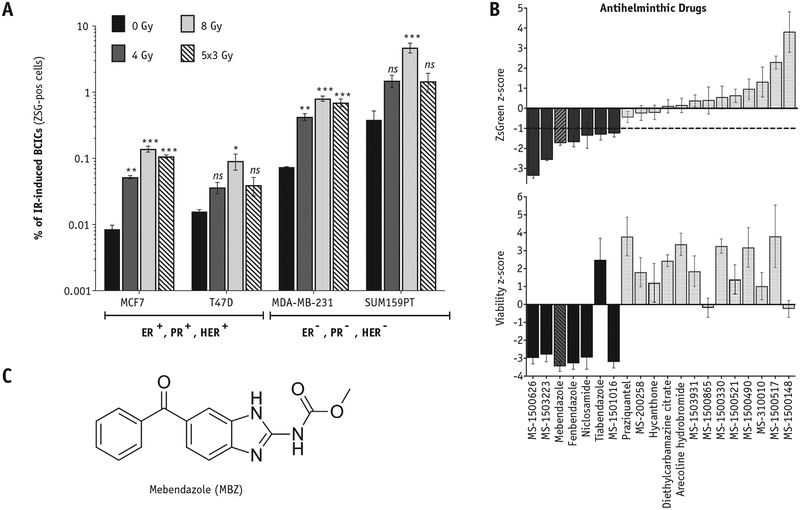Fig. 1.
Select anthelminthic drugs can inhibit radiation-induced dedifferentiation in triple-negative breast cancer. (A) Breast cancer cells derived from luminal breast cancer (MCF7 and T47D) and triple-negative breast cancer (MDA-MB-231 and SUM159PT) were depleted of BCICs via high-speed FACS. BCICs were identified via a fluorescent reporter system that reports for low proteasome activity (ZsGreen-cODC, ZSG-pos) in BCICs.8 The sorted, noninitiating cells (ZSG-neg) received different doses of irradiation, and 5 days later the percentage of spontaneous (0 Gy) and radiation-induced (4 Gy, 8 Gy, and 5 daily fractions of 3 Gy) ZSG-pos BCICs was estimated via flow cytometry. Paired, 2-tailed t test: *P < .001; **P < .001; ***P < .0001; ns, not significant. (B) Drugs with anthelminthic properties were tested in a low-throughput assay for the ability to inhibit radiation-induced dedifferentiation of noninitiating (ZSG-neg) breast cancer cells into IR-induced BCICs (induced-ZSG-pos) using the SUM159PT TNBC line. SUM159PT-ZSG-neg cells were isolated via high-speed FACS, plated on 384-well plates containing 10 μM of the anthelminthic drugs, and irradiated with 8 Gy the following day. After 5 days, the cells were stained with the viability dye, Hoechst 33342, and the number of dedifferentiated ZSG-pos cells (B, top panel) and viable cells (B, bottom panel) was determined via a laser-scanning cytometer. The <mi> scores were calculated based on the DMSO control values. MBZ (striped bars) efficiently inhibited radiation-induced dedifferentiation while also resulting in significant toxicity to the bulk cell population. (C) The structure of MBZ. Abbreviations: BCICs = breast cancer-initiating cells; DMSO = dimethyl sulfoxide; FACS = fluorescence activated cell sorting; IR = ionizing radiation; MBZ = mebendazole.

